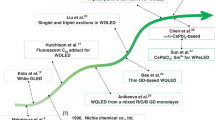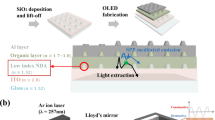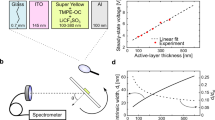Abstract
The application of organic light-emitting devices to reduce the energy consumption of interior lighting, which now costs more than $230 billion annually1, is attracting interest due to the high efficiency of these devices. Indeed, electrophosphorescent organic light-emitting devices with an internal quantum efficiency ηIQE of 100% (refs 2,3) already approach the efficiency of fluorescent lamps4,5,6. However, because of the high refractive index of organic materials and the optical confinement and internal reflection that results, the light out-coupling efficiency ηout for conventional organic light-emitting devices is limited to ∼20% (refs 2,7). Here we demonstrate that embedding a low-index grid in the organic layers can enhance the out-coupling of the waveguided light without spectral distortion. When combined with microlenses that out-couple the glass modes, the external quantum efficiency ηEQE and power efficiency of a white organic light-emitting device are improved to 34 ± 2% and 68 ± 4 lm W–1. The resulting ηout is 2.3 ± 0.2 times that of a conventional organic light-emitting device used as a comparison, and simulations indicate that the enhancement can be further increased to 3.4 ± 0.2.
This is a preview of subscription content, access via your institution
Access options
Subscribe to this journal
Receive 12 print issues and online access
$209.00 per year
only $17.42 per issue
Buy this article
- Purchase on Springer Link
- Instant access to full article PDF
Prices may be subject to local taxes which are calculated during checkout




Similar content being viewed by others
References
Mills, E. The $230 billion Global Lighting Energy Bill. Proceedings of the 5th International Conference on Energy-Efficient Lighting (2002).
Adachi, C., Baldo, M. A., Thompson, M. E. & Forrest, S. R. Nearly 100% internal phosphorescence efficiency in an organic light-emitting device. J. Appl. Phys. 90, 5048–5051 (2001).
Baldo, M. A. et al. Highly efficient phosphorescent emission from organic electroluminescent devices. Nature 395, 151–154 (1998).
D'Andrade, B. W. & Forrest, S. R. White organic light-emitting devices for solid-state lighting. Adv. Mater. 16, 1585–1595 (2004).
Sun, Y. & Forrest, S. R. High-efficiency white organic light emitting devices with three separate phosphorescent emission layers. Adv. Mater. 16, 1585–1595 (2004).
Williams, E. L., Haavisto, K., Li, J. & Jabbour, G. E. Excimer-based white phosphorescent organic light emitting diodes with nearly 100% internal quantum efficiency. Adv. Mater. 19, 197–202 (2007).
Chutinan, A., Ishihara, K., Asano, T., Fujita, M. & Noda, S. Theoretical analysis on light-extraction efficiency of organic light-emitting diodes using FDTD and mode-expansion methods. Org. Elect. 6, 3–9 (2005).
Bulovic, V. et al. Weak microcavity effects in organic light-emitting devices. Phys. Rev. B 58, 3730–3740 (1998).
Gu, G., Burrows, P. E., Venkatesh, S., Forrest, S. R. & Thompson, M. E. High-external-quantum-efficiency organic light-emitting devices. Opt. Lett. 22, 396–398 (1997).
Zhou, X. et al. High-efficiency electrophosphorescent organic light-emitting diodes with double light-emitting layers. Appl. Phys. Lett. 81, 4070–4072 (2002).
Moller, S. & Forrest, S. R. Improved light out-coupling in organic light emitting diodes employing ordered microlens arrays. J. Appl. Phys. 91, 3324–3327 (2002).
Nakamura, T., Tsutsumi, N., Juni, N. & Fujii, H. Thin-film waveguiding mode light extraction in organic electroluminescent device using high refractive index substrate. J. Appl. Phys. 97, 054505 (2005).
Sun, Y. & Forrest, S. R. Organic light emitting devices with enhanced out-coupling via microlenses fabricated by imprint lithography. J. Appl. Phys. 100, 073106 (2006).
Nakayama, T., Hiyama, K., Furukawa, K. & Ohtani, H. Development of phosphorescent white OLED with extremely high power efficiency and long lifetime. Society for Information Display Digest 19, 1018–1021 (2007).
Do, Y. R., Kim, Y. C., Song, Y. W. & Lee, Y. H. Enhanced light extraction efficiency from organic light emitting diodes by insertion of a two-dimensional photonic crystal structure. J. Appl. Phys. 96, 7629–7636 (2004).
Feng, J. & Okamoto, T. Enhancement of electroluminescence through a two-dimensional corrugated metal film by grating-induced surface-plasmon cross coupling. Opt. Lett. 30, 2302–2304 (2005).
Agrawal, M., Sun, Y., Forrest, S. R. & Peumans, P. Enhanced out-coupling from organic light-emitting diodes using aperiodic dielectric mirrors. Appl. Phys. Lett. 90, 241112 (2007).
Tsutsui, T., Yahiro, M., Yokogawa, H. & Kawano, K. Doubling coupling-out efficiency in organic light-emitting devices using a thin silica aerogel layer. Adv. Mater. 13, 1149–1152 (2001).
Ziebarth, J. M. & McGehee, M. D. A theoretical and experimental investigation of light extraction from polymer light-emitting diodes. J. Appl. Phys. 97, 064502 (2005).
Gifford, D. K. & Hall, D. G. Emission through one of two metal electrodes of an organic light-emitting diode via surface-plasmon cross coupling. Appl. Phys. Lett. 81, 4315–4317 (2002).
Wu, S. T. & Yang, D. K. Fundamentals of Liquid Crystal Devices (Wiley, New York, 2006).
Ngaffo, F. F. et al. Deposition of ITO films on SiO2 substrates. Appl. Surf. Sci. 248, 428–432 (2005).
Baldo, M. A. & Forrest, S. R. Transient analysis of organic electrophosphorescence: I. Transient analysis of triplet energy transfer. Phys. Rev. B 62, 10958–10966 (2000).
Acknowledgements
The authors thank the US Department of Energy for support through a subcontract from the University of Southern California and Universal Display Corporation for partial financial support of this work.
Author information
Authors and Affiliations
Corresponding author
Rights and permissions
About this article
Cite this article
Sun, Y., Forrest, S. Enhanced light out-coupling of organic light-emitting devices using embedded low-index grids. Nature Photon 2, 483–487 (2008). https://doi.org/10.1038/nphoton.2008.132
Received:
Accepted:
Published:
Issue Date:
DOI: https://doi.org/10.1038/nphoton.2008.132
This article is cited by
-
Light management for perovskite light-emitting diodes
Nature Nanotechnology (2023)
-
Ultrapure green organic light-emitting diodes based on highly distorted fused π-conjugated molecular design
Nature Photonics (2023)
-
Nanoscale plasmonic wires with maximal figure of merits as a superior flexible transparent conducting electrode for RGB colors
Scientific Reports (2022)
-
Anisotropic nanocrystal superlattices overcoming intrinsic light outcoupling efficiency limit in perovskite quantum dot light-emitting diodes
Nature Communications (2022)
-
Air-Stable Ultrabright Inverted Organic Light-Emitting Devices with Metal Ion-Chelated Polymer Injection Layer
Nano-Micro Letters (2022)



